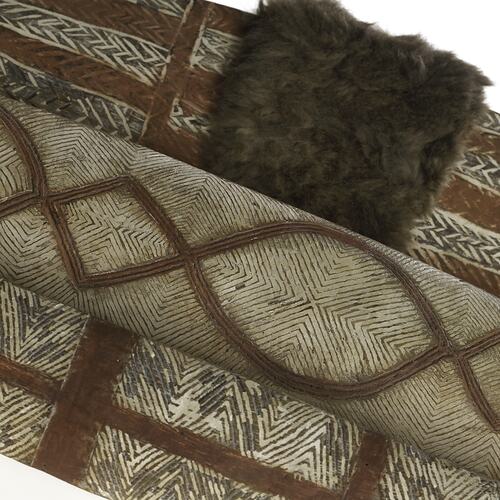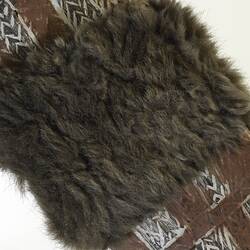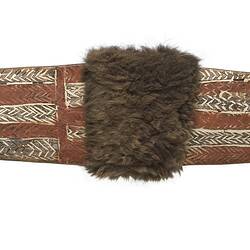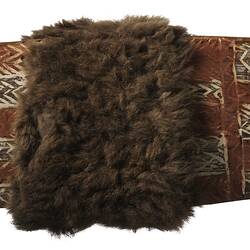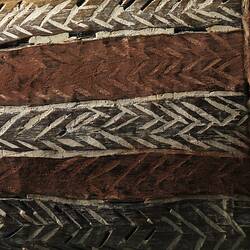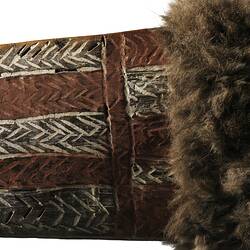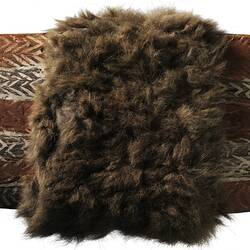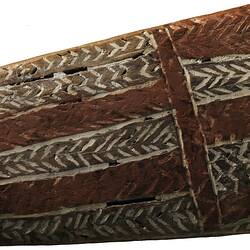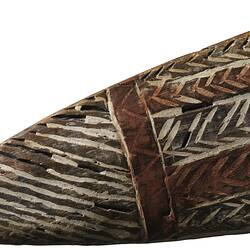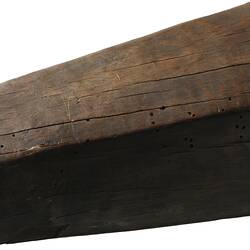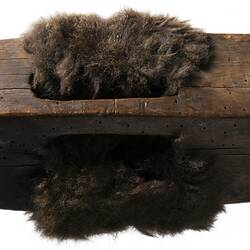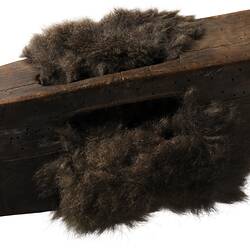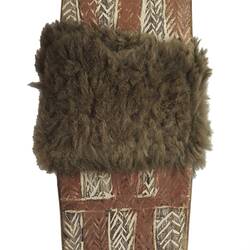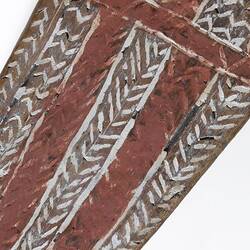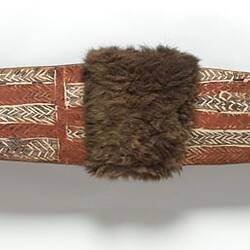Summary
These distinctive narrow malka (parrying shields) were used to deflect spears and wooden clubs in combat. The designs on the malka were meant to be visually arresting with dexterous combatants able to use them to create distracting optical illusions in battle. Tools made of stone and animal teeth like the sharp teeth of a marsupial were used to shape the malka and engrave the designs onto the face. Malka could also be regarded as having innate power and older malka used in many successful battles were prized objects of trade. The piece of possum fur wrapped around the middle is designed to protect a man's knuckles during a fight. The ornamentation relates to the makers' individual and group identities, and were important markers identifying individuals and clans in combat.
Rodney Carter, a Dja Dja Wurrung/Yorta Yorta man, speaks of the multilayered and complex messages the patterning on shields hold;
'For me, the shields or the symbols upon the shields represent identity. You can liken them to what we use now as titles for our houses. The lines, the colours, the carvings- they tell people who you are and, more importantly, they tell people where you come from.' Rodney Carter, 2009
Local Name
Malka
Physical Description
The strong parrying shields made from hardwood originated in south-eastern Australia. They were designed to deflect the heavy wooden clubs that were prominent in the armour of the Aboriginal men of this part of Australia. Variations in design occurred across the different groups and regions. Malka have a distinctly triangular cross-section. The three faces are flat, with the outer face generally ornamented with engraved designs, ochre and pipeclay. The handle is carved from the single piece of timber by removing a section of wood from the angle forming the apex of the triangle at the shield's back. The other styles of parrying shield, the tawarrang and drunmung, were more wedged-shaped. Their outer faces were gently convex to round, in shape and some were made with a distinctive dome shape on their top. The ornamentation relates to the makers' individual and group identities, and were important markers identifying individuals and clans in combat. The designs were visually arresting, and dexterous warriors were able to use the designs to create distracting optical illusions in battle. The piece of possum fur around the middle section of the shield was for protecting the knuckles of the user during a fight.
Significance
The strong malka (parrying shields) made from hardwood originated in south-eastern Australia. They were designed to deflect the heavy wooden clubs that were prominent in the armour of the Aboriginal men of this part of Australia. Variations in design occurred across the different groups and regions.
Malka have a distinctly triangular cross-section. The three faces are flat, with the outer face generally ornamented with engraved designs, ochre and pipeclay. The handle is carved from the single piece of timber by removing a section of wood from the angle forming the apex of the triangle at the shield's back. The other styles of parrying shield, the tawarrang and drunmung, were more wedged-shaped. Their outer faces were gently convex to round, in shape and some were made with a distinctive dome shape on their top.
The history of 'ownership' of such objects between leaving the possession of Aboriginal people and becoming part of Museum Victoria collections is diverse and often obscure. Early collectors acquired objects such as these because it was ignorantly believed that Aboriginal people were 'a dying race'. This false belief and the growing interest in ethnography created a very active trade in First Peoples objects from the mid-nineteenth century onwards. As with this malka, it was common for collectors and institutions to be ignorant of the diversity and specificity of the culture of the First Peoples of Australia and therefore makers, their language group and homelands were often not recorded. However, items can be partially identified by common artistic styles belonging to specific areas of Australia.
References
Keeler, C. and Couzens, V., (eds) 2010, Meerreeng-An, Here is my Country: The Story of Aboriginal Victoria Told Through Art, p.156, Koorie Heritage Trust/ BPA Print Group.
More Information
-
Object/Medium
Shield
-
Maker
-
Locality
-
Date Produced
-
Date Collected
-
Object Measurements
910 mm (Length), 160 mm (Width), 110 mm (Height)
-
Classification
-
Keywords
-
References
[Book] Museum Victoria. 2004. Treasures of the Museum. Victoria, Australia. 206.
-
Acquisition Information
Purchase from (Estate of) Henry A. Smith, Mr H F. Richardson, 07 May 1888
-
Collection Names
-
Type of item
-
Discipline
-
Category
-
Collecting Areas
